Addressing Obesity in Australia: A Public Policy and Health Report
VerifiedAdded on 2023/06/07
|8
|1525
|406
Report
AI Summary
This report focuses on the critical public health issue of obesity in Australia, highlighting its prevalence and impact on the population, particularly among teenagers. It examines the current role of the government in addressing the epidemic, including awareness campaigns, healthcare reforms, and the promotion of cultural change. The report identifies key institutions and agencies involved, such as the Ministry of Health, NGOs, schools, and families, emphasizing the need for a collaborative approach. Opportunities for change are explored, emphasizing the importance of public awareness and the implementation of lifestyle changes. The report addresses the need for cultural shifts, changes in food consumption habits, and the integration of physical activity in schools. It emphasizes the need for involvement from government, non-governmental organizations, schools, and families to tackle the growing health risks associated with obesity and weight gain. The report also includes references to support the analysis.
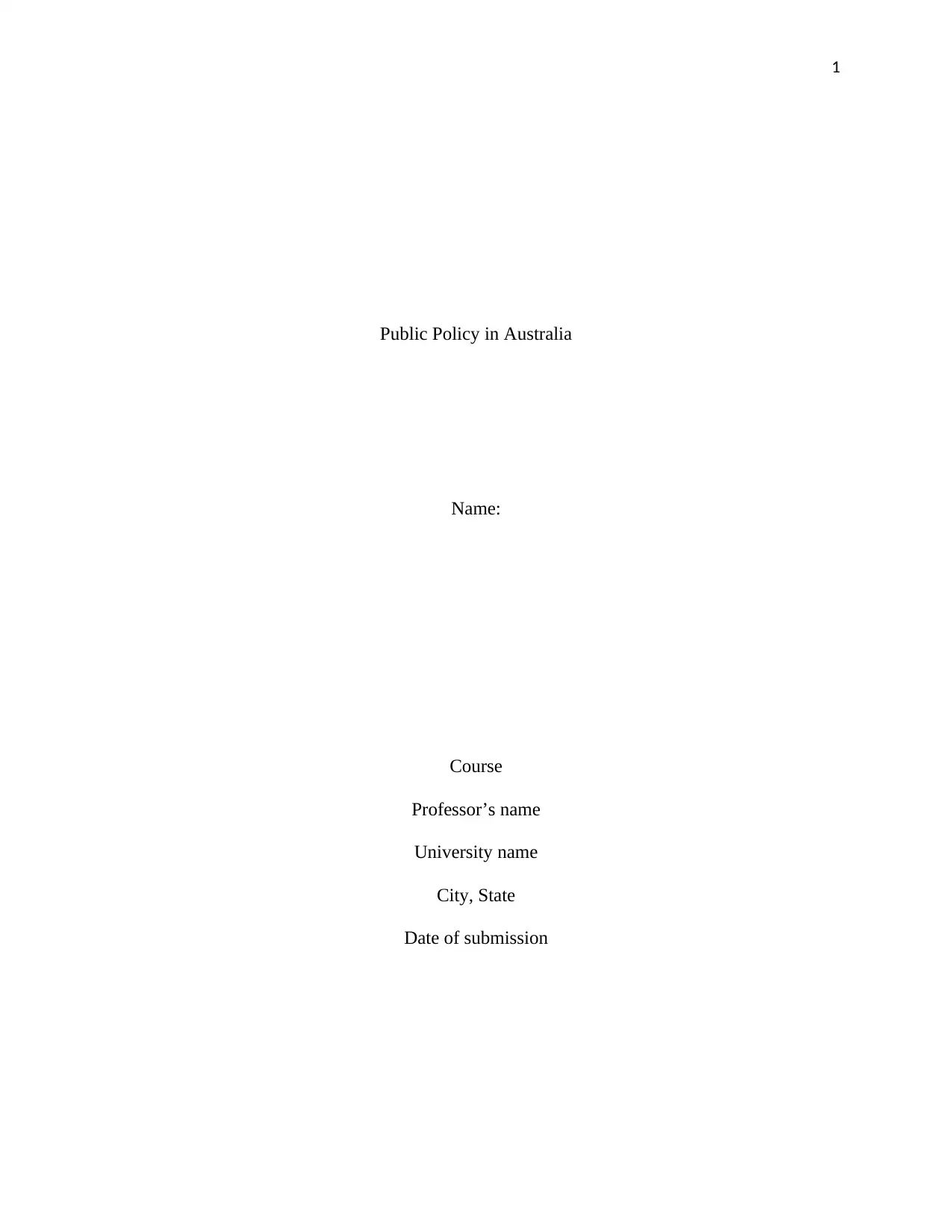
1
Public Policy in Australia
Name:
Course
Professor’s name
University name
City, State
Date of submission
Public Policy in Australia
Name:
Course
Professor’s name
University name
City, State
Date of submission
Paraphrase This Document
Need a fresh take? Get an instant paraphrase of this document with our AI Paraphraser
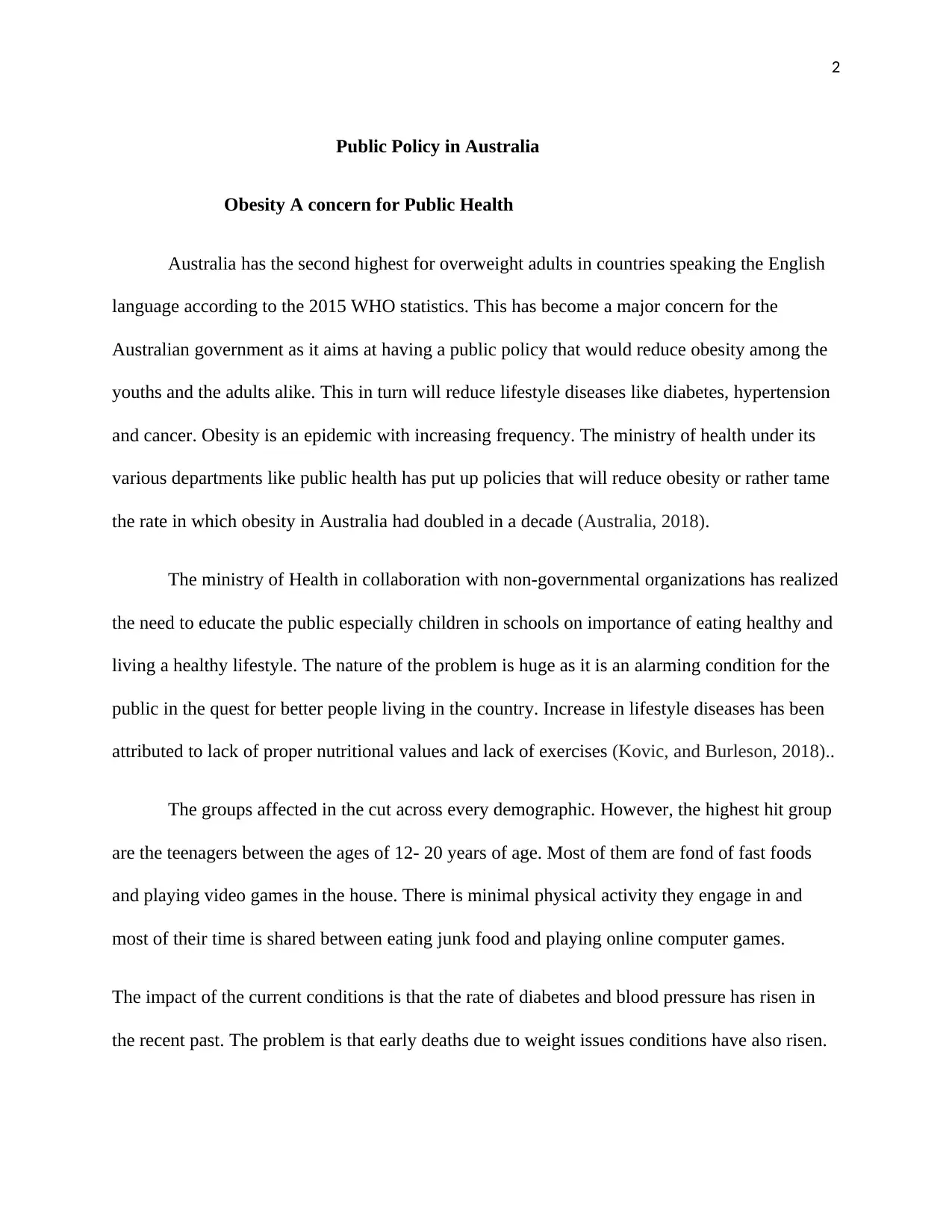
2
Public Policy in Australia
Obesity A concern for Public Health
Australia has the second highest for overweight adults in countries speaking the English
language according to the 2015 WHO statistics. This has become a major concern for the
Australian government as it aims at having a public policy that would reduce obesity among the
youths and the adults alike. This in turn will reduce lifestyle diseases like diabetes, hypertension
and cancer. Obesity is an epidemic with increasing frequency. The ministry of health under its
various departments like public health has put up policies that will reduce obesity or rather tame
the rate in which obesity in Australia had doubled in a decade (Australia, 2018).
The ministry of Health in collaboration with non-governmental organizations has realized
the need to educate the public especially children in schools on importance of eating healthy and
living a healthy lifestyle. The nature of the problem is huge as it is an alarming condition for the
public in the quest for better people living in the country. Increase in lifestyle diseases has been
attributed to lack of proper nutritional values and lack of exercises (Kovic, and Burleson, 2018)..
The groups affected in the cut across every demographic. However, the highest hit group
are the teenagers between the ages of 12- 20 years of age. Most of them are fond of fast foods
and playing video games in the house. There is minimal physical activity they engage in and
most of their time is shared between eating junk food and playing online computer games.
The impact of the current conditions is that the rate of diabetes and blood pressure has risen in
the recent past. The problem is that early deaths due to weight issues conditions have also risen.
Public Policy in Australia
Obesity A concern for Public Health
Australia has the second highest for overweight adults in countries speaking the English
language according to the 2015 WHO statistics. This has become a major concern for the
Australian government as it aims at having a public policy that would reduce obesity among the
youths and the adults alike. This in turn will reduce lifestyle diseases like diabetes, hypertension
and cancer. Obesity is an epidemic with increasing frequency. The ministry of health under its
various departments like public health has put up policies that will reduce obesity or rather tame
the rate in which obesity in Australia had doubled in a decade (Australia, 2018).
The ministry of Health in collaboration with non-governmental organizations has realized
the need to educate the public especially children in schools on importance of eating healthy and
living a healthy lifestyle. The nature of the problem is huge as it is an alarming condition for the
public in the quest for better people living in the country. Increase in lifestyle diseases has been
attributed to lack of proper nutritional values and lack of exercises (Kovic, and Burleson, 2018)..
The groups affected in the cut across every demographic. However, the highest hit group
are the teenagers between the ages of 12- 20 years of age. Most of them are fond of fast foods
and playing video games in the house. There is minimal physical activity they engage in and
most of their time is shared between eating junk food and playing online computer games.
The impact of the current conditions is that the rate of diabetes and blood pressure has risen in
the recent past. The problem is that early deaths due to weight issues conditions have also risen.
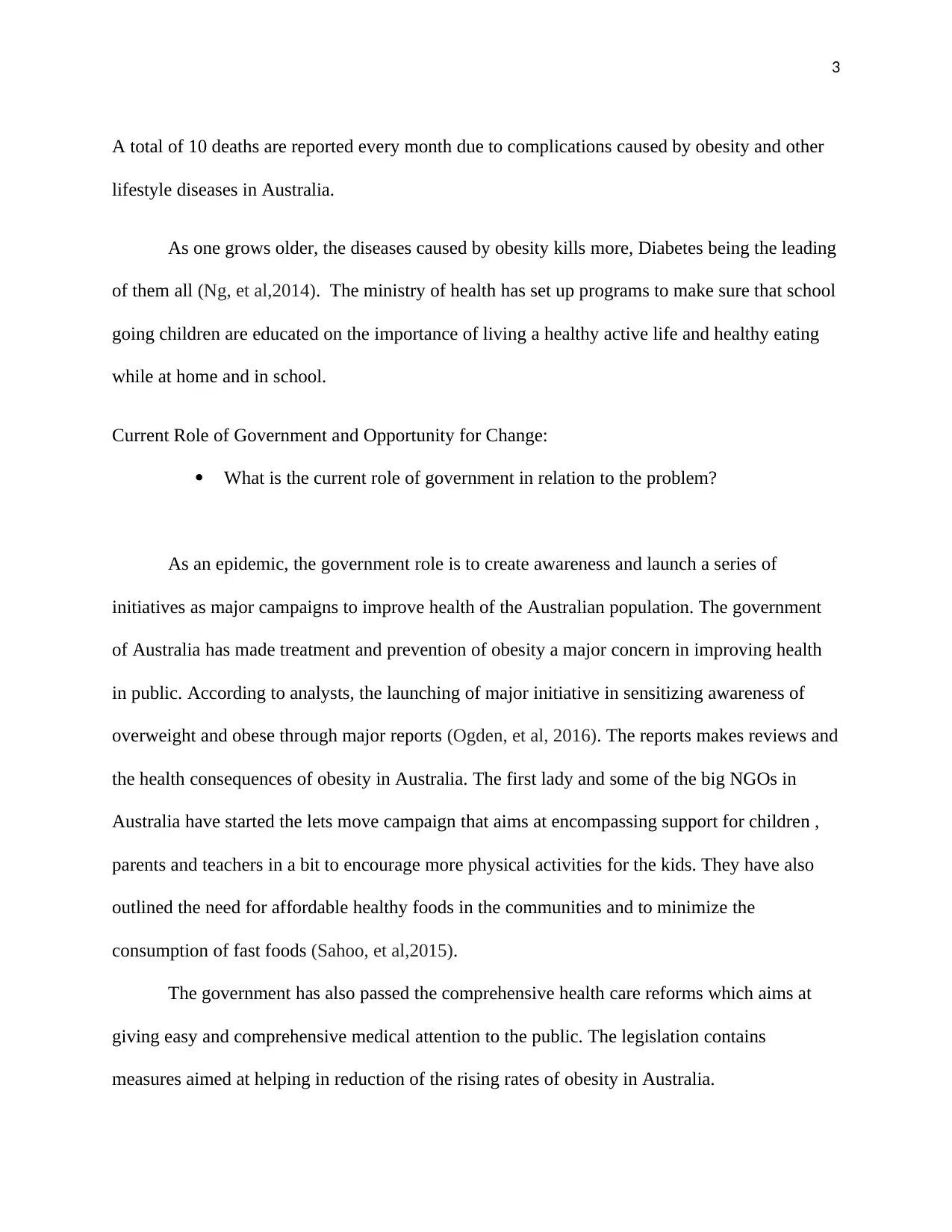
3
A total of 10 deaths are reported every month due to complications caused by obesity and other
lifestyle diseases in Australia.
As one grows older, the diseases caused by obesity kills more, Diabetes being the leading
of them all (Ng, et al,2014). The ministry of health has set up programs to make sure that school
going children are educated on the importance of living a healthy active life and healthy eating
while at home and in school.
Current Role of Government and Opportunity for Change:
What is the current role of government in relation to the problem?
As an epidemic, the government role is to create awareness and launch a series of
initiatives as major campaigns to improve health of the Australian population. The government
of Australia has made treatment and prevention of obesity a major concern in improving health
in public. According to analysts, the launching of major initiative in sensitizing awareness of
overweight and obese through major reports (Ogden, et al, 2016). The reports makes reviews and
the health consequences of obesity in Australia. The first lady and some of the big NGOs in
Australia have started the lets move campaign that aims at encompassing support for children ,
parents and teachers in a bit to encourage more physical activities for the kids. They have also
outlined the need for affordable healthy foods in the communities and to minimize the
consumption of fast foods (Sahoo, et al,2015).
The government has also passed the comprehensive health care reforms which aims at
giving easy and comprehensive medical attention to the public. The legislation contains
measures aimed at helping in reduction of the rising rates of obesity in Australia.
A total of 10 deaths are reported every month due to complications caused by obesity and other
lifestyle diseases in Australia.
As one grows older, the diseases caused by obesity kills more, Diabetes being the leading
of them all (Ng, et al,2014). The ministry of health has set up programs to make sure that school
going children are educated on the importance of living a healthy active life and healthy eating
while at home and in school.
Current Role of Government and Opportunity for Change:
What is the current role of government in relation to the problem?
As an epidemic, the government role is to create awareness and launch a series of
initiatives as major campaigns to improve health of the Australian population. The government
of Australia has made treatment and prevention of obesity a major concern in improving health
in public. According to analysts, the launching of major initiative in sensitizing awareness of
overweight and obese through major reports (Ogden, et al, 2016). The reports makes reviews and
the health consequences of obesity in Australia. The first lady and some of the big NGOs in
Australia have started the lets move campaign that aims at encompassing support for children ,
parents and teachers in a bit to encourage more physical activities for the kids. They have also
outlined the need for affordable healthy foods in the communities and to minimize the
consumption of fast foods (Sahoo, et al,2015).
The government has also passed the comprehensive health care reforms which aims at
giving easy and comprehensive medical attention to the public. The legislation contains
measures aimed at helping in reduction of the rising rates of obesity in Australia.
⊘ This is a preview!⊘
Do you want full access?
Subscribe today to unlock all pages.

Trusted by 1+ million students worldwide
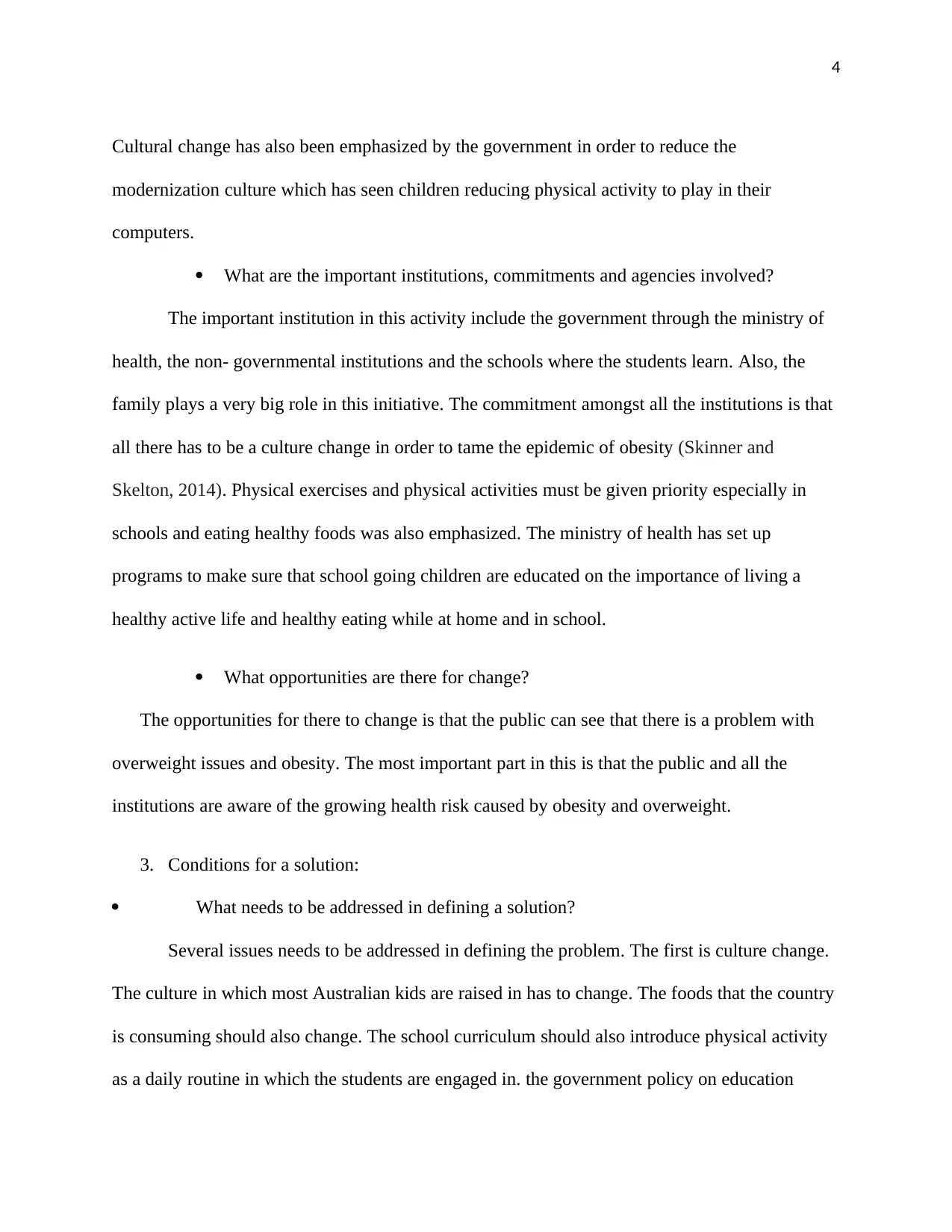
4
Cultural change has also been emphasized by the government in order to reduce the
modernization culture which has seen children reducing physical activity to play in their
computers.
What are the important institutions, commitments and agencies involved?
The important institution in this activity include the government through the ministry of
health, the non- governmental institutions and the schools where the students learn. Also, the
family plays a very big role in this initiative. The commitment amongst all the institutions is that
all there has to be a culture change in order to tame the epidemic of obesity (Skinner and
Skelton, 2014). Physical exercises and physical activities must be given priority especially in
schools and eating healthy foods was also emphasized. The ministry of health has set up
programs to make sure that school going children are educated on the importance of living a
healthy active life and healthy eating while at home and in school.
What opportunities are there for change?
The opportunities for there to change is that the public can see that there is a problem with
overweight issues and obesity. The most important part in this is that the public and all the
institutions are aware of the growing health risk caused by obesity and overweight.
3. Conditions for a solution:
What needs to be addressed in defining a solution?
Several issues needs to be addressed in defining the problem. The first is culture change.
The culture in which most Australian kids are raised in has to change. The foods that the country
is consuming should also change. The school curriculum should also introduce physical activity
as a daily routine in which the students are engaged in. the government policy on education
Cultural change has also been emphasized by the government in order to reduce the
modernization culture which has seen children reducing physical activity to play in their
computers.
What are the important institutions, commitments and agencies involved?
The important institution in this activity include the government through the ministry of
health, the non- governmental institutions and the schools where the students learn. Also, the
family plays a very big role in this initiative. The commitment amongst all the institutions is that
all there has to be a culture change in order to tame the epidemic of obesity (Skinner and
Skelton, 2014). Physical exercises and physical activities must be given priority especially in
schools and eating healthy foods was also emphasized. The ministry of health has set up
programs to make sure that school going children are educated on the importance of living a
healthy active life and healthy eating while at home and in school.
What opportunities are there for change?
The opportunities for there to change is that the public can see that there is a problem with
overweight issues and obesity. The most important part in this is that the public and all the
institutions are aware of the growing health risk caused by obesity and overweight.
3. Conditions for a solution:
What needs to be addressed in defining a solution?
Several issues needs to be addressed in defining the problem. The first is culture change.
The culture in which most Australian kids are raised in has to change. The foods that the country
is consuming should also change. The school curriculum should also introduce physical activity
as a daily routine in which the students are engaged in. the government policy on education
Paraphrase This Document
Need a fresh take? Get an instant paraphrase of this document with our AI Paraphraser
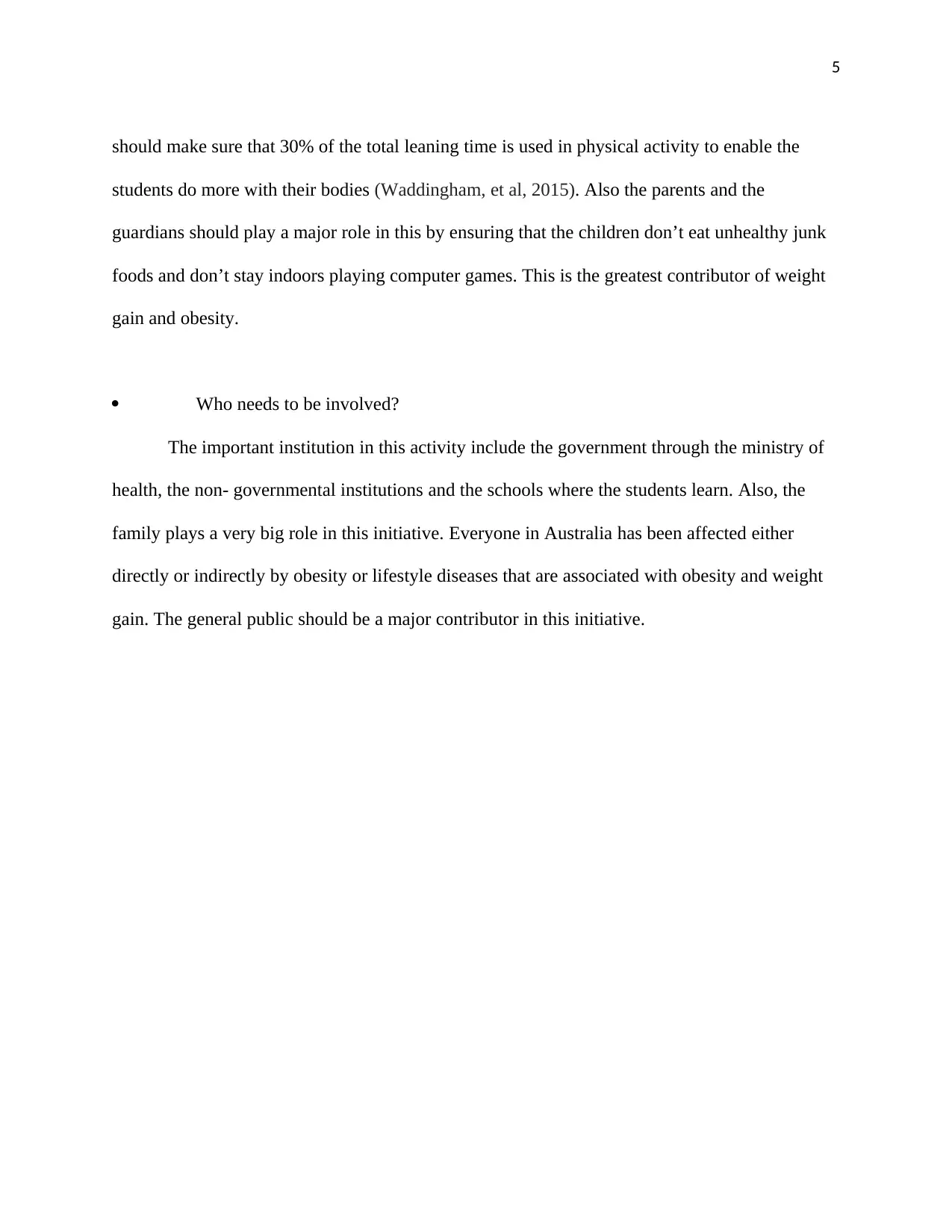
5
should make sure that 30% of the total leaning time is used in physical activity to enable the
students do more with their bodies (Waddingham, et al, 2015). Also the parents and the
guardians should play a major role in this by ensuring that the children don’t eat unhealthy junk
foods and don’t stay indoors playing computer games. This is the greatest contributor of weight
gain and obesity.
Who needs to be involved?
The important institution in this activity include the government through the ministry of
health, the non- governmental institutions and the schools where the students learn. Also, the
family plays a very big role in this initiative. Everyone in Australia has been affected either
directly or indirectly by obesity or lifestyle diseases that are associated with obesity and weight
gain. The general public should be a major contributor in this initiative.
should make sure that 30% of the total leaning time is used in physical activity to enable the
students do more with their bodies (Waddingham, et al, 2015). Also the parents and the
guardians should play a major role in this by ensuring that the children don’t eat unhealthy junk
foods and don’t stay indoors playing computer games. This is the greatest contributor of weight
gain and obesity.
Who needs to be involved?
The important institution in this activity include the government through the ministry of
health, the non- governmental institutions and the schools where the students learn. Also, the
family plays a very big role in this initiative. Everyone in Australia has been affected either
directly or indirectly by obesity or lifestyle diseases that are associated with obesity and weight
gain. The general public should be a major contributor in this initiative.
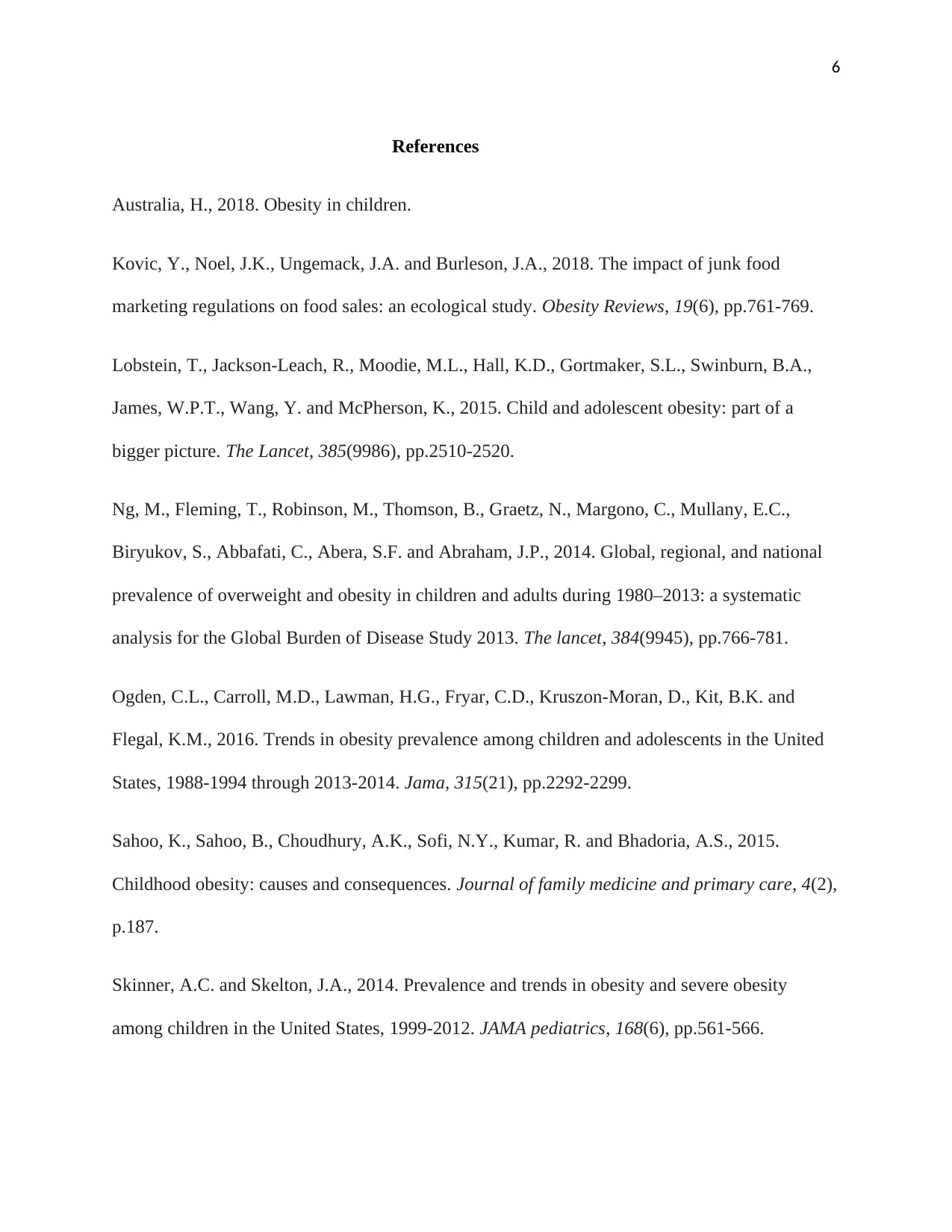
6
References
Australia, H., 2018. Obesity in children.
Kovic, Y., Noel, J.K., Ungemack, J.A. and Burleson, J.A., 2018. The impact of junk food
marketing regulations on food sales: an ecological study. Obesity Reviews, 19(6), pp.761-769.
Lobstein, T., Jackson-Leach, R., Moodie, M.L., Hall, K.D., Gortmaker, S.L., Swinburn, B.A.,
James, W.P.T., Wang, Y. and McPherson, K., 2015. Child and adolescent obesity: part of a
bigger picture. The Lancet, 385(9986), pp.2510-2520.
Ng, M., Fleming, T., Robinson, M., Thomson, B., Graetz, N., Margono, C., Mullany, E.C.,
Biryukov, S., Abbafati, C., Abera, S.F. and Abraham, J.P., 2014. Global, regional, and national
prevalence of overweight and obesity in children and adults during 1980–2013: a systematic
analysis for the Global Burden of Disease Study 2013. The lancet, 384(9945), pp.766-781.
Ogden, C.L., Carroll, M.D., Lawman, H.G., Fryar, C.D., Kruszon-Moran, D., Kit, B.K. and
Flegal, K.M., 2016. Trends in obesity prevalence among children and adolescents in the United
States, 1988-1994 through 2013-2014. Jama, 315(21), pp.2292-2299.
Sahoo, K., Sahoo, B., Choudhury, A.K., Sofi, N.Y., Kumar, R. and Bhadoria, A.S., 2015.
Childhood obesity: causes and consequences. Journal of family medicine and primary care, 4(2),
p.187.
Skinner, A.C. and Skelton, J.A., 2014. Prevalence and trends in obesity and severe obesity
among children in the United States, 1999-2012. JAMA pediatrics, 168(6), pp.561-566.
References
Australia, H., 2018. Obesity in children.
Kovic, Y., Noel, J.K., Ungemack, J.A. and Burleson, J.A., 2018. The impact of junk food
marketing regulations on food sales: an ecological study. Obesity Reviews, 19(6), pp.761-769.
Lobstein, T., Jackson-Leach, R., Moodie, M.L., Hall, K.D., Gortmaker, S.L., Swinburn, B.A.,
James, W.P.T., Wang, Y. and McPherson, K., 2015. Child and adolescent obesity: part of a
bigger picture. The Lancet, 385(9986), pp.2510-2520.
Ng, M., Fleming, T., Robinson, M., Thomson, B., Graetz, N., Margono, C., Mullany, E.C.,
Biryukov, S., Abbafati, C., Abera, S.F. and Abraham, J.P., 2014. Global, regional, and national
prevalence of overweight and obesity in children and adults during 1980–2013: a systematic
analysis for the Global Burden of Disease Study 2013. The lancet, 384(9945), pp.766-781.
Ogden, C.L., Carroll, M.D., Lawman, H.G., Fryar, C.D., Kruszon-Moran, D., Kit, B.K. and
Flegal, K.M., 2016. Trends in obesity prevalence among children and adolescents in the United
States, 1988-1994 through 2013-2014. Jama, 315(21), pp.2292-2299.
Sahoo, K., Sahoo, B., Choudhury, A.K., Sofi, N.Y., Kumar, R. and Bhadoria, A.S., 2015.
Childhood obesity: causes and consequences. Journal of family medicine and primary care, 4(2),
p.187.
Skinner, A.C. and Skelton, J.A., 2014. Prevalence and trends in obesity and severe obesity
among children in the United States, 1999-2012. JAMA pediatrics, 168(6), pp.561-566.
⊘ This is a preview!⊘
Do you want full access?
Subscribe today to unlock all pages.

Trusted by 1+ million students worldwide

7
Waddingham, S., Stevens, S., Macintyre, K. and Shaw, K., 2015. “Most of them are junk food
but we did put fruit on there and we have water” What children can tell us about the food choices
they make. Health Education, 115(2), pp.126-140.
Waddingham, S., Stevens, S., Macintyre, K. and Shaw, K., 2015. “Most of them are junk food
but we did put fruit on there and we have water” What children can tell us about the food choices
they make. Health Education, 115(2), pp.126-140.
Paraphrase This Document
Need a fresh take? Get an instant paraphrase of this document with our AI Paraphraser

8
1 out of 8
Related Documents
Your All-in-One AI-Powered Toolkit for Academic Success.
+13062052269
info@desklib.com
Available 24*7 on WhatsApp / Email
![[object Object]](/_next/static/media/star-bottom.7253800d.svg)
Unlock your academic potential
Copyright © 2020–2025 A2Z Services. All Rights Reserved. Developed and managed by ZUCOL.





